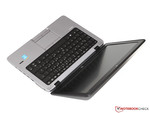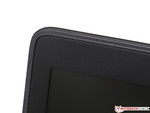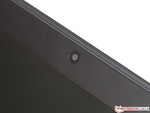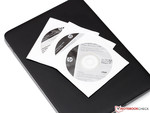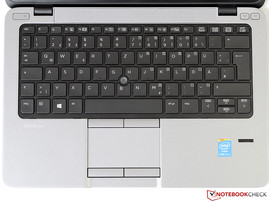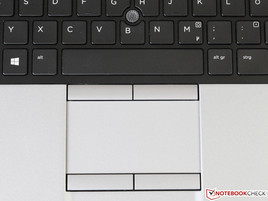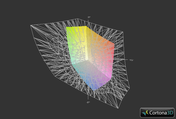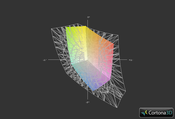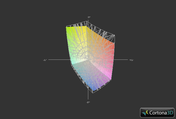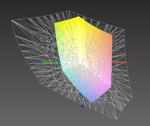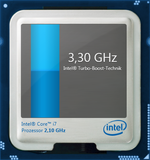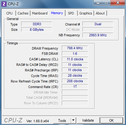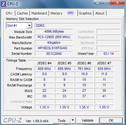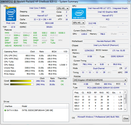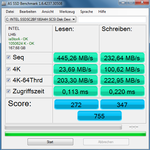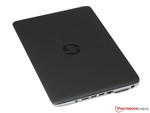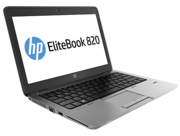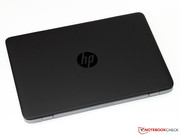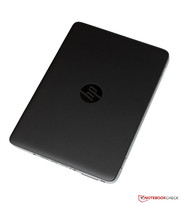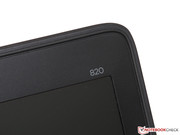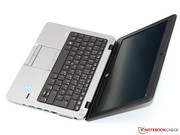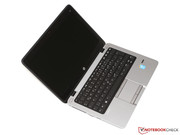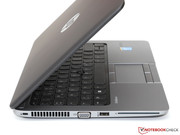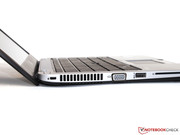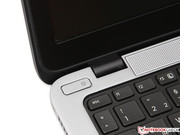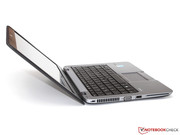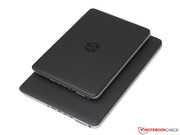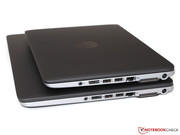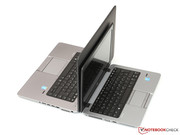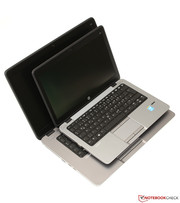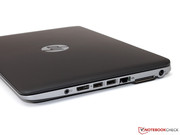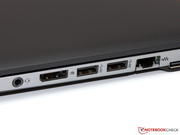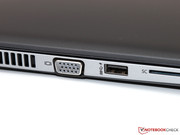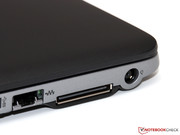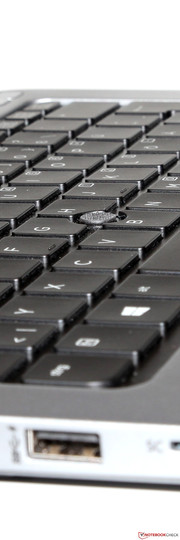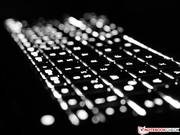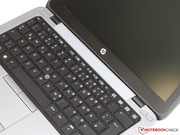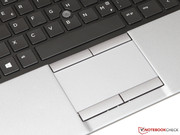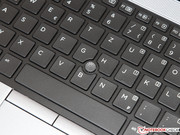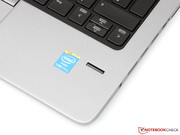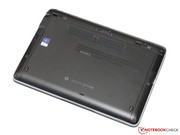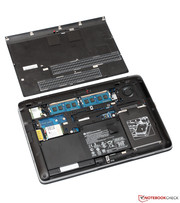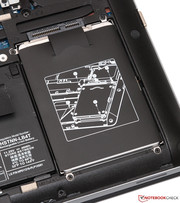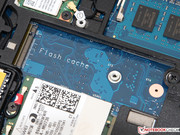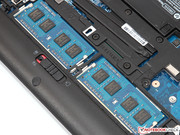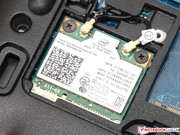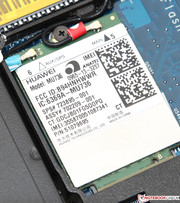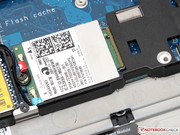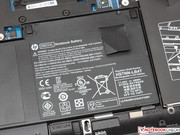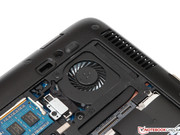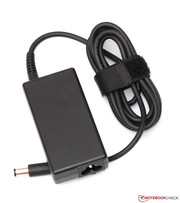Review HP EliteBook 820 G1-H5G14ET Subnotebook

For the original German review, see here.
On the go business people usually have very clear requirements on their wish-laptop: It must be reliable and secure, and sufficiently fast for the used applications. However, special focus is also placed on weight and battery runtime - particularly when the laptop is taken along on extended business trips.
Compact, 12-inch laptops are made just for this purpose as they try to master the balancing act between maximum portability and high (remaining) user value. The EliteBook 820 G1 plays this role at HP. The entry-level model features a Core i5 processor alongside 4 GB of RAM, and a 500 GB HDD for approximately 1000 Euros (~$1394). Configurations of considerably higher performance are also available. A steep 1700 Euros (~$2370) are demanded for our review sample that sports a Core i7-4600U, 8 GB of RAM, a 180 GB SSD storage, and a mobile wireless module - a lot of money for such a small laptop. At least all models include a 3-year warranty, a matte screen with 1366x768 pixels and the free choice between Windows 7 or 8 (both Professional).
As so often, HP faces strong contenders from Dell and Lenovo in the form of the Latitude E7240 and the ThinkPad X240. The price of all three is very close, which will likely make it an exciting battle for the crown of this category.
| EliteBook 820 G1 (H5G05ET) | EliteBook 820 G1 (F1R80AW) | EliteBook 820 G1 (H5G14ET) |
|---|---|---|
| Core i5-4200U | Core i5-4300U | Core i7-4600U |
| 4 GB RAM | 4 GB RAM | 8 GB RAM |
| 500 GB (HDD) | 180 GB (SSD) | 180 GB (SSD) |
| HD Graphics 4400 | HD Graphics 4400 | HD Graphics 4400 |
| 12.5", 1366 x 768 pixels | 12.5", 1.366 x 768 pixels | 12.5", 1366 x 768 pixels |
| no WWAN | no WWAN | UMTS/HSPA+ |
| from 1000 Euros | from 1600 Euros | from 1700 Euros |
Case
HP introduced a new design line with the EliteBook 800 range. It relies on curved shapes and restrained colors, primarily black and silver. This dress looks just as good on the 820 G1 as on the recently tested 850 G1. The matte surfaces also prove to be resistant and insensitive to smudging. HP even promises that the laptop has successfully been tested according to the MIL-STD-810 US military standard.
The EliteBook is almost completely made of magnesium, which is supposed to make an approximately 30 percent lower weight possible compared with the precursor. Nevertheless, our review sample weighs over 1.5 kilograms (~3.3 pounds), which is also due to the lush configuration. In any case, the chassis provides outstanding performance in terms of rigidity and stability, and even defies the strongest pressure completely unimpressed. The screen, rimmed by a protective rubber lip, can also be warped by only a few millimeters using high force. Both massive metal hinges limit any wobbling of the lid to a minimum, and are yet so smooth running that only one hand is needed for opening.
Like the bigger sister model, the 820 G1's meticulous build is impressive. We did not discover any sharp edges or irregular material transitions; the manufacturer should only rectify the slight play between the display bezel and screen.
Connectivity
In the course of redesigning the case, HP crossed out several outdated interfaces, such as the ExpressCard slot and the obsolete 56k modem. Besides that, all interfaces have been moved to both casing's sides. The user now has three USB 3.0 ports, two display sockets (VGA and DisplayPort), a headset jack, and Gbit LAN available. Buying the approximately 170 Euros (~$237) "UltraSlim DockingStation" might be worth considering should that not be enough. It is connected to the laptop's side, and supplies additional USB and monitor ports.
Overall, the interface positioning can be called good. However, we again have to reproach the very difficult to reach card reader. Instead of placing it below the USB ports, HP could have simply used an empty space on the laptop's front.
Communication
The manufacturer installs different Wi-Fi modules depending on the configuration; in our case, it is Intel's Dual-Band Wireless-N 7260. Although this mid-range model does not feature the latest ac standard, it supports 802.11 a/b/g/n, and consequently also transmits in the less frequented 5 GHz band. Transmission rates of up to 300 Mbps can be reached owing to dual-stream technology (2x2), providing an appropriate router is on the other side. The EliteBook proved to have an above average range, and excellent connection stability even in difficult reception conditions in our practical test (o2 Box 4421, max. 150 Mbps).
In addition to Wi-Fi and Bluetooth 4.0, our review sample also sports a mobile broadband modem (HP hs 3110), which enables the user to browse via UMTS/HSPA+ on the go. Inserting a corresponding SIM card was a bit inconvenient because it has to be inserted in a slot under the battery.
The same 0.9 megapixel webcam including the array microphone as found in the EliteBook 850 G1 is available for video conferencing. The picture and sound quality are acceptable for communication purposes, but the primary camera of every low-priced smartphone provides much better results.
Security
Protecting the laptop against (physical) theft is not the only security issue for laptops, but in particular protecting the stored data. HP therefore relies on extensive hardware and software technologies, which include a specially protected BIOS, and an optional file and drive encryption. Physically, the EliteBook can be protected against theft with a Kensington lock, but it can also be located and/or remote locked (Computrace and Intel Anti-Theft) in real emergencies. Naturally, a fingerprint scanner should not be omitted, which is a convenient alternative, or a supplement for normal passwords.
Accessories
Since Windows 8 is not widely accepted in the professional field, HP installs the older Windows 7 Professional (64-bit) ex-factory, but includes the installation and driver DVDs for both operating systems. Apart from that, the accessories are only comprised of the usual leaflets, a matching 45-Watt power supply, and various programs, such as PowerDVD 12 and a PDF reader.
Maintenance
A practical slide mechanism secures the 820 G1's base plate, and thus allows maintenance without tools. Since both memory banks and the 2.5-inch slot (7 mm height) of our review sample are furnished, only the empty M.2 slot (NGFF 2242) is left for potential upgrading. Naturally, the installed components can be replaced. Except for the soldered CPU, virtually the entire hardware can be exchanged in a few steps. Only removing and cleaning the processor's fan would involve disassembling the device even further.
Warranty
HP includes a 3-year warranty on the laptop and the battery, which can be upgraded via so-called "Care Packs". Buyers who are satisfied with a basic pick-up and return service can upgrade (U7868E) to a total of 4 years for approximately 130 Euros (~$180); a 5-year warranty, including accidental damage and on-site service (UL786E, UM236E) quickly surpasses 500 Euros (~$700).
Input Devices
Keyboard
The EliteBook 820 G1 largely adopts the chiclet keyboard of the bigger 850 G1, but sacrifices one row of function keys (Scroll, Pos1, End, etc.) for space reasons. Otherwise, important similarities such as splash water protection and a two level backlight are still available, and the character keys' size of 14 x 14 millimeters has not been altered.
We published an in-depth report about the keyboard's typing feel and pressure point in a former review, to which we would like to refer to here. Nevertheless, there are minor differences. The yielding keyboard center that we criticized in the 15-inch model is virtually non-existent in the 820 G1. Subjectively, the keyboard provides a much crisper feedback, and thus achieves an even better rating.
Touchpad and TrackPoint
Unlike Lenovo's laptop, HP does not integrate the mouse keys directly in the touchpad. Although the input field is relatively small for this reason (85 x 46 millimeters; ~3.3 x 1.8 inches), the higher user comfort more than compensates that. Good gliding properties and the high accuracy almost make the pad a full-blown mouse replacement. The various multi-touch gestures with up to three fingers also facilitate routine use.
An alternative is the so-called Pointstick that we closely examined before. Apart from the omitted scroll button, it also does an excellent job. All four mouse buttons - the TrackPoint and mouse pad have dedicated buttons - thrill with a firm, yet barely audible stroke that strongly underlines the generally high quality level.
Display
One of the biggest shortcomings of the old EliteBook 2560p was the extremely mediocre screen that did not deliver satisfying performance in any of the tests. Has the manufacturer recognized and eliminated this problem?
Nothing has changed in resolution. 1366x768 pixels (125 dpi) are more or less acceptable in a 12.5-inch screen. However, the 820 G1 cannot compete with either the ThinkPad X240 or Latitude E7240, which have an optional Full HD screen. Consequently, users who deal with complex programs or large Excel spreadsheets will quickly find the limits of the small desktop surface.
In return, slight improvements are seen in the screen's maximum brightness, which has been increased from 165 to 211 cd/m². For comparison: We ascertained exactly the same rate in the (non-touch) E7240, although our review sample does not come close to the optional premium screens from Lenovo or Dell, which cost extra. At least the screen does not display distracting flickering or bleeding, and the luminosity is distributed evenly over the entire screen.
| |||||||||||||||||||||||||
Brightness Distribution: 86 %
Center on Battery: 227 cd/m²
Contrast: 363:1 (Black: 0.63 cd/m²)
ΔE Color 10.75 | 0.5-29.43 Ø5
ΔE Greyscale 11.72 | 0.57-98 Ø5.3
37% AdobeRGB 1998 (Argyll 1.6.3 3D)
40.98% AdobeRGB 1998 (Argyll 2.2.0 3D)
59% sRGB (Argyll 2.2.0 3D)
39.89% Display P3 (Argyll 2.2.0 3D)
Gamma: 2.62
HP opted for a basic TN screen from AU Optronics with the model name AUO206C for its EliteBook. It unfortunately cannot render a truly saturated black (0.63 cd/m² at maximum brightness), which results in a modest contrast ratio of just 363:1. However, this point is not as significant for a business device as it would be for a multimedia laptop. The image quality is definitely sufficient for office tasks.
A marginal note about the screen's color reproduction, which will be of interest primarily for photographers and graphic designers. A color space coverage of only 54 percent in the sRGB standard disqualifies the 820 G1 for many professional applications. Besides that, the screen exhibits extreme color and grayscale shifts. While they at least can be partially rectified via calibration, the visible bluish cast remains even in the ideal image settings.
Despite its screen's matte surface, the EliteBook is not without limitations for outdoor use. Although the screen's maximum brightness is also achieved in battery mode, the rate of roughly 200 cd/m² is simply too low to defy bright sunlight. The manufacturer should most certainly make improvements here. A slight surcharge will unlikely make a difference considering the very high base price.
Typical for a TN, the screen proves to be very viewing angle dependent, and only supplies a true image from a straight-on view. The slightest movements, particularly up and down, cause an intense brightness loss and color deviations. The optional "HD Premium UWVA screen" promises better performance, although it is likely only a high-quality IPS screen. Unfortunately, only the "HD SVA screen" that we tested is on the market until now. The user can alternatively use an external monitor that renders a sharp and flicker-free image even via VGA (tested with up to 1920x1080 pixels).
Update July 2014 - IPS HD screen:
A version of HP's Elitebook 820 with a higher-quality IPS screen has now found its way into our tests. The device incorporates a screen from LG Philips (LGD0404) and like the base configuration, offers the same resolution of 1366x768 pixels on a screen diagonal of 12.5 inches (125 ppi). The available desktop thus remains the same, but the screen's rates have been improved considerably.
For example, the average brightness of very good 355 cd/m² is well beyond the base TN screen with approximately 210 cd/m². The maximum contrast has also been improved, and is now good 703:1 (cf. 363:1 in the TN screen).
| |||||||||||||||||||||||||
Brightness Distribution: 82 %
Center on Battery: 384 cd/m²
Contrast: 703:1 (Black: 0.548 cd/m²)
ΔE Color 5.99 | 0.5-29.43 Ø5
ΔE Greyscale 5.7 | 0.57-98 Ø5.3
40.63% AdobeRGB 1998 (Argyll 1.6.3 3D)
44.23% AdobeRGB 1998 (Argyll 2.2.0 3D)
64.1% sRGB (Argyll 2.2.0 3D)
42.77% Display P3 (Argyll 2.2.0 3D)
Gamma: 2.05
How does that look in relation to the contenders? The following comparison chart shows the three rivals, Elitebook 820, Thinkpad X240, and Latitude E7240 all with an HD screen. The clearly better rates of both IPS solutions in the Elitebook and Thinkpad, which are vastly superior to the HD models regarding brightness, contrast, and color reproduction, quickly becomes evident. Dell and Lenovo however still have another ace up their sleeve: Both the Thinkpad X240 and the Latitude E7240 are optionally available with a higher resolution Full HD IPS screen.
| HP EliteBook 820 G1 TN HD | HP EliteBook 820 G1 IPS HD | Lenovo ThinkPad X240 IPS HD | Dell Latitude E7240 TN HD | |
|---|---|---|---|---|
| Display | ||||
| Display P3 Coverage | 39.89 | 42.77 7% | 43.05 8% | 41.14 3% |
| sRGB Coverage | 59 | 64.1 9% | 64.2 9% | 61.7 5% |
| AdobeRGB 1998 Coverage | 40.98 | 44.23 8% | 44.56 9% | 42.52 4% |
| Screen | ||||
| Brightness middle | 229 | 385 68% | 361 58% | 211 -8% |
| Brightness | 211 | 355 68% | 340 61% | 211 0% |
| Brightness Distribution | 86 | 82 -5% | 91 6% | 81 -6% |
| Black Level * | 0.63 | 0.548 13% | 0.507 20% | 0.631 -0% |
| Contrast | 363 | 703 94% | 712 96% | 334 -8% |
| Colorchecker dE 2000 * | 10.75 | 5.99 44% | 3.78 65% | 8.45 21% |
| Greyscale dE 2000 * | 11.72 | 5.7 51% | 3.34 72% | 9.03 23% |
| Gamma | 2.62 84% | 2.05 107% | 2.58 85% | 2.58 85% |
| CCT | 15283 43% | 6594 99% | 6695 97% | 10616 61% |
| Color Space (Percent of AdobeRGB 1998) | 37 | 40.63 10% | 41 11% | 39 5% |
* ... smaller is better
Although the deviations of the reproduced colors and grayscale of the IPS model is significantly better in state of delivery than the TN version, ideal conditions can first be achieved via calibration using a spectrophotometer (icc file in the above visualization available). The color space coverage of approximately 40% of AdobeRGB is not much better than that of the TN version. This issue is however only important for a handful of graphic/print experts.
Performance
The limited cooling capacity of the small 12-inch chassis requires the use of energy-efficient ULV processors that are based on Intel's latest Haswell architecture, and which the contenders also use. Depending on the configuration, HP installs various Core i3 and Core i5 CPUs; our premium model even sports the Core i7-4600U. Its base speed of 2.1 GHz can be increased up to 3.3 GHz via Turbo Boost (2 cores: 2.9 GHz). Additionally, Hyperthreading improves the multi-threading performance. Intel builds the chip in a 22-nanometer process, and it is specified with a TDP of only 15 Watts (including the chipset).
Since it does not sport a dedicated solution from AMD or Nvidia, the integrated HD Graphics 4400 takes care of all graphic tasks. The medium, also called "GT2", expansion stage of the Haswell GPU features 20 execution units (EUs) with a clock of 200 up to 1100 MHz.
A swift dual-channel connection to the main memory is necessary so that the graphics unit can max out its full performance. This prerequisite is given in the form of two 4 GB DDR3L-1600 modules, which gives the 820 G1 an advantage over the ThinkPad X240 that only sports one memory slot. We were also pleased with the large 180 GB SSD - but more about that below.
Processor
The low TDP of, specifically, the faster Haswell generation ULV models, prevents maintaining the maximum Turbo Boost constant for a long time - even with optimal cooling. Therefore, it is not surprising that the Core i7-4600U gradually reduces it initial clock of 2.9 GHz to approximately 2.6 GHz in Cinebench R11.5. The frequency varies between 3.0 and 3.3 GHz when one core is loaded, and is at the upper end of our expectations.
The good Turbo utilization allows the EliteBook to gain a slight edge on the ThinkPad with the same CPU. The secret star is, however, the Core i5-4300U in the Latitude E7240. In practical use, its clock is not much lower than that of the i7-4600U, particularly during full load, begging the question, is the i7 worth its surcharge.
Regrettably, HP has again decided to limit the performance artificially in battery mode. The clock drops to the base speed of 2.1 GHz without the power supply, which leads to a performance loss of 20 to 35 percent.
Update July 2014 - Intel i7 4510U CPU
In addition to the screen, our updated configuration also sports a new CPU. Apart from a marginally lower clock bandwidth (2.0 - 3.1 GHz vs. 2.1 - 3.3 GHz), Intel's i7 4510U does not involve any significant modification compared with the i7 4600U in the original test setup. We even ascertained a slight advantage for the new 4510U chip in Cinebench R11.5 single-thread test, while the version featuring the i7 4600U keeps the lead in the multi-thread test. Overall, the chip is just behind the i7 4600U and just before the i5 4300U.
| Cinebench R11.5 | |
| CPU Single 64Bit (sort by value) | |
| HP EliteBook 820 G1 | |
| Dell Latitude E7240 | |
| Dell Latitude E7240 Touch | |
| Lenovo ThinkPad X240 | |
| CPU Multi 64Bit (sort by value) | |
| HP EliteBook 820 G1 | |
| Dell Latitude E7240 | |
| Dell Latitude E7240 Touch | |
| Lenovo ThinkPad X240 | |
Storage Devices
The Intel SSD Pro 1500 is a sister model of the familiar Intel SSD 530 Series from the consumer range, and it additionally supports business features like vPro. The hardware of both drives is identical: Intel uses the somewhat older SF-2281 SandForce Controller alongside its own firmware and MLC-NAND built in 20 nm. A five-year manufacturer warranty promises good reliability, and explains the relatively high price.
Although the SSD Pro 1500 does not achieve the absolute top performance, the contenders do not really have much of a lead. Compared with the Samsung SSD 840 in the ThinkPad X240, the Intel model lags behind only slightly in read speeds (in particular 4K-64), but the ascertained differences are not noticed in everyday use.
System Performance
According to the system performance benchmarks of the PCMark series, the EliteBook 820 G1 is currently one of the swiftest devices of its category. However, we could not yet test the Latitude E7240 in a comparable Core i7 configuration. Like in the CPU tests, the ThinkPad falls behind a bit despite its identical processor, which is due to its limited Turbo Boost.
There should only be a few situations that exhaust the laptop's performance reserves in practical use. Owing to the SSD, the operating system and applications load without significant waiting times, and the processor also easily copes with demanding software and multitasking. Anyway, a noticeable performance boost would only be achieved by means of a quad-core CPU, which is hardly feasible in this form factor.
| PCMark 7 Score | 5196 points | |
| PCMark 8 Home Score Accelerated v2 | 3624 points | |
| PCMark 8 Creative Score Accelerated v2 | 3045 points | |
| PCMark 8 Work Score Accelerated v2 | 5363 points | |
Help | ||
Graphics Card
As mentioned earlier, the swift memory interface considerably increases the graphics performance of the HD Graphics 4400 depending on the benchmark. While the synthetic 3DMark 11 benchmark only displays low increases of around 15 percent, the frame rate gains roughly 30 percent and more in other cases. These increases are welcome in view of the generally low performance level that is far remote from a dedicated GeForce 710M. We did not ascertain a performance difference between AC and battery mode.
However, the HD 4400 has enough reserves for basic 3D applications and multimedia purposes, and it supports many up-to-date features. Besides OpenCL support, the fast Quick Sync Transcoder is particularly interesting. While the CPU converts an H.264 video (Big Buck Bunny 1080p, CyberLink MediaEspresso) for the iPhone 5 in exactly 8 minutes, the same task is completed after just 61 seconds using Quick Sync.
| 3DMark 11 - 1280x720 Performance GPU (sort by value) | |
| HP EliteBook 820 G1 | |
| Dell Latitude E7240 Touch | |
| Lenovo ThinkPad X240 | |
| Apple MacBook Air 11 inch 2013-06 1.7 GHz 256 GB | |
| 3DMark 06 Standard Score | 5852 points | |
| 3DMark Vantage P Result | 3999 points | |
| 3DMark 11 Performance | 937 points | |
| 3DMark Ice Storm Standard Score | 41559 points | |
| 3DMark Cloud Gate Standard Score | 4636 points | |
| 3DMark Fire Strike Score | 592 points | |
Help | ||
Gaming Performance
The 820 G1 can smoothly render most current 3D games in low to medium graphic settings, with the exception of a few very demanding games like the newest Need for Speed sequel. However, visual enhancements or even additional anti-aliasing are usually not possible, which seems bearable for a laptop of this category.
| low | med. | high | ultra | |
| Anno 2070 (2011) | 61 | 28.4 | 17.2 | |
| Diablo III (2012) | 56.7 | 36.2 | 29.7 | |
| Tomb Raider (2013) | 49.4 | 24.3 | 14.3 | |
| Dota 2 (2013) | 65.5 | 35.1 | 14.9 | |
| Total War: Rome II (2013) | 35.8 | 26.7 | 20.1 |
Emissions
System Noise
Although the fan is completely inactive only when absolutely idle, the EliteBook is a quiet and unobtrusive companion. The noise level ranges around 31 dB(A) in the lowest speeds, which are active when, for example, browsing or in MS Office applications. Consequently, the device is almost inaudible even in quiet surroundings, especially since using an SSD eliminates any potential noise from a storage device.
The noise increases quite fast up to almost 36 dB(A) in full load, and remains stable at this level. The constant and not unduly high-pitched noise from the small fan is not distracting even over a longer period. This is a good result considering the high performance and the small casing.
Noise Level
| Idle |
| 29.6 / 30.7 / 31.3 dB(A) |
| Load |
| 35.7 / 35.8 dB(A) |
 | ||
30 dB silent 40 dB(A) audible 50 dB(A) loud |
||
min: | ||
Temperature
The low noise development is only one side of the coin – the temperatures also have stayed within limits. The 820 G1 masters this balancing act perfectly, and barely surpasses 40 °C (104 °F) even during full load. Except for one measuring zone, all rates remain clearly below this temperature so that the laptop can be used on the thighs without hesitation.
The casing's inner temperatures are just as uncritical. Our stress test, consisting of Prime95 and FurMark, drive the CPU to approximately 65 °C (149 °F); the manufacturer specifies a maximum of 100 °C (212 °F), which will unlikely come close to being reached even in warm summer months. The CPU's throttling to 1.2 GHz can be explained with the TDP's limit of 15 Watts. The graphics unit claims the majority of that, and its clock rate settles to 850 MHz.
An interesting side note: The second memory module causes the uncore area's consumption to increase by a good 0.5 Watts. When removed, the CPU and GPU can achieve an almost 100 MHz higher clock rate.
(+) The maximum temperature on the upper side is 39.7 °C / 103 F, compared to the average of 35.9 °C / 97 F, ranging from 21.4 to 59 °C for the class Subnotebook.
(±) The bottom heats up to a maximum of 41.9 °C / 107 F, compared to the average of 39.4 °C / 103 F
(+) In idle usage, the average temperature for the upper side is 26.5 °C / 80 F, compared to the device average of 30.7 °C / 87 F.
(+) The palmrests and touchpad are reaching skin temperature as a maximum (33.3 °C / 91.9 F) and are therefore not hot.
(-) The average temperature of the palmrest area of similar devices was 28.3 °C / 82.9 F (-5 °C / -9 F).
Speakers
Both speakers located above the keyboard disappoint with their high-pitched and weak sound that completely lacks bass. The high maximum volume that is quickly accompanied by distortions is one of the speakers' few advantages. Connecting an external sound system thus seems recommendable. The low-noise jack or an external USB solution can be used for this purpose.
Energy Management
Power Consumption
The EliteBook is satisfied with 3.2 to 7.5 Watts when idling, and is on par with both the Latitude E7240 (3.7 to 6.6 Watts) and the ThinkPad X240 (3.9 to 7.3 Watts). Therefore, the 820 G1's considerably darker screen apparently does not offer any significant advantages in consumption.
Due to the aforementioned throttling, we measured the maximum consumption of 34.4 Watts using 3DMark 06 rather than in the usual stress test (26.8 Watts). In view of these low rates, the capacity of the included 45-Watt power supply, which is the same model as for the larger 850 G1, is quite sufficient.
| Off / Standby | |
| Idle | |
| Load |
|
Battery Runtime
Although the battery now integrated into the casing has been extremely slimmed down compared with the precursor, its 46 Wh should make quite solid runtimes possible owing to the energy-efficient hardware.
In fact, runtimes ranging from 2 hours in Battery Eaters Classic test (high-performance, maximum brightness, wireless modules on) and 13.5 hours in the Reader's test (energy-saving mode, minimum brightness, wireless modules off) are very impressive. A practical runtime of approximately 6 hours is realistic, as our Wi-Fi and H.264 assessments using an adapted screen brightness (~150 cd/m²) show. Overall, the EliteBook places itself exactly between the Latitude E7240 and ThinkPad X240, which both have an identically sized battery.
HP also offers a smaller battery with only 26 Wh in some regions. Its runtimes should decrease proportionately.
Verdict
Home run: HP has created a compelling subnotebook with the EliteBook 820 G1. It comprehensively meets the requirements placed on a portable, professional office device.
We especially liked the generally high quality standard that ranges from the casing over the input devices up to small details, such as the well-conceived maintenance cover. All these properties are also found in the comparatively affordable base model though. The appeal of our premium configuration is primarily found in the superior memory equipment, and the additional UMTS modem. Consequently, users who want to use the device mainly in the office can easily save a few hundred Euros. The lower-priced examples of this series should also offer long battery runtimes and low emissions.
So far, so good - if it were not for the screen. Its extreme viewing angle dependency, poor color reproduction, and middling brightness let us ask whether this is necessary in a laptop from this price range. Lenovo and Dell both offer optional Full HD displays with an IPS screen - why not HP? The EliteBook's spec sheets list an alternative "premium" screen that only has a resolution of 1366x768 pixels, but which is not installed in any regional model.
How the potential buyer sees this drawback is ultimately something everyone has to decide for themselves. Nevertheless, the EliteBook 820 G1 made an overall outstanding impression on us, and thus qualifies itself as a serious contender for both the Latitude E7240 and ThinkPad X240.
Update 07/2014: The alternative IPS screen is now available in Germany. We tested a version of the Elitebook 820 G1 (model number: J2A93AV, configured in HP's online shop), and ascertained significant improvements in brightness, color reproduction, and viewing angle stability in contrast to the base screen.


 Deutsch
Deutsch English
English Español
Español Français
Français Italiano
Italiano Nederlands
Nederlands Polski
Polski Português
Português Русский
Русский Türkçe
Türkçe Svenska
Svenska Chinese
Chinese Magyar
Magyar